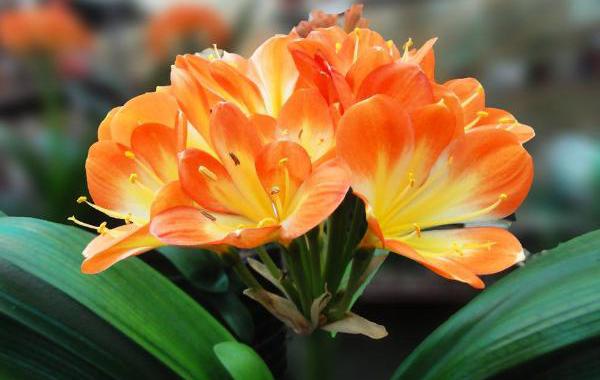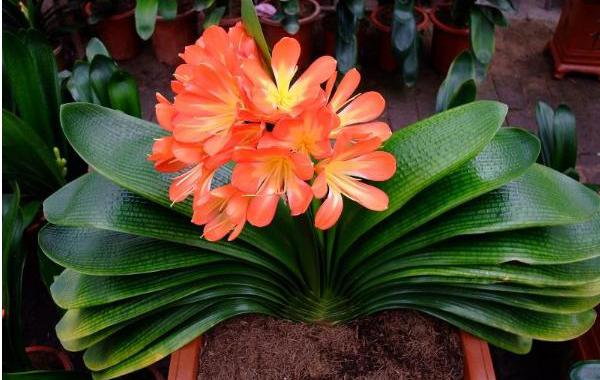Analysis and solution of several abnormal phenomena in Magnolia

Many kinds of flowers, love flowers friends are meticulous care of their own flowers, today Xiaobian for everyone to introduce several common abnormal phenomenon analysis and solutions about Clivia, so that planting Clivia friends encounter such a situation has a certain solution.
1. Abnormal phenomena such as irregular arrangement of leaves of Clivia sinensis
Some Clivia leaves are prone to seven twists and eight twists, which is because there is less auxin on the sunny side of the leaves and the leaves grow slowly; the auxin on the backlight side is more and grows faster, while the stems and leaves are always bent toward the slow growth side, which is prone to "crooked leaves" phenomenon. Therefore, the flowerpot should be rotated regularly during maintenance, and the growth season is generally rotated once every 7 days; the slow growth season is generally rotated once every 10 days. If there are leaves not in a straight line, you can use two bamboo strips bent into a semicircle inserted into the soil, clamping the leaves, after a period of time can gradually adjust over; can also be shaped by light, that is, opaque thick paper cut into strips of length and width basically consistent with the leaves, and then longitudinally folded from the middle, wrapped by sunlight oblique direction of half of the leaves, and then transparent adhesive tape will be stuck on the front and back sides of the leaves, after 10 to 15 days, the long crooked leaves will be corrected.
2. Abnormal phenomena of stem tip and yellow edge of Clivia
Dry tip and yellow edge potted Clivia should maintain sufficient light, but it is not resistant to strong light, if the light is too strong, dry air, poor ventilation will appear dry tip, yellow edge phenomenon. Therefore, special attention should be paid to increasing environmental humidity in management.
III. Clivia with arrows
There are many reasons for arrow clamping, such as inappropriate temperature and improper watering. For adult Clivia, when the vegetative growth of the plant is transferred to reproductive growth, attention should be paid to the change of pseudobulb. If pseudobulb protrusion is found and one side is hypertrophy, it indicates that flower arrow is forming. At this time, fertilization should be stopped for two weeks, otherwise it will cause leaf sheath and pseudobulb to be harder and more stressed, causing arrow clamping. If the bulb pressure is too large to cause the arrow clip, you can use a sterile knife to cut the leaf sheath that clips the arrow bud 1.5 cm, reduce the pressure of the leaf sheath stem on the arrow bud, and promote the arrow bud to jump out.
4. Clivia rotted roots
There are many reasons for the rotten roots of Clivia, such as the wound is not disinfected when potted, and the root rot bacteria invade from the wound; the root system is damaged when transplanting and changing pots; improper fertilization during growth produces reverse osmosis phenomenon, causing dehydration and death of the root system; there are many ponding in the pot, causing rotten roots; soil alkalization, basin soil hardening, poor water permeability, etc. To prevent root rot, in addition to disinfection and sterilization of the culture soil when the pot is placed, it is necessary to fertilize and water reasonably. Once rotten roots occur, the plants can be taken out of the flowerpot, soil removed, washed clean with clean water, rotten roots and dead roots cut off, soaked in 0.1% potassium permanganate for 5 minutes for disinfection, and then applied plant ash or sulfur powder on the wound for disinfection. After the treatment, it will be shallow planted into new culture soil, buried roots can be, and then poured once permeable water, placed in a shady environment at 20 DEG C maintenance, new leaves after growth can be normal management.
Clivia vitality is strong, easy to cultivate, but it is not easy to raise well. Especially in daily management, there are often abnormal phenomena such as irregular arrangement of leaves, which affect its ornamental value.
Some Clivia leaves are prone to seven twists and eight twists, which is because there is less auxin on the sunny side of the leaves and the leaves grow slowly; the auxin on the backlight side is more and grows faster, while the stems and leaves are always bent toward the slow growth side, which is prone to "crooked leaves" phenomenon. Therefore, the flowerpot should be rotated regularly during maintenance, and the growth season is generally rotated once every 7 days; the slow growth season is generally rotated once every 10 days. If the leaves are not in a straight line, two bamboo strips can be bent into a semicircle and inserted into the soil to clamp the leaves. After a period of time, they can be gradually adjusted. Can also be shaped by light, that is, with opaque thick paper cut into long and wide and leaves basically consistent with the paper, and then longitudinal from the middle of the fold, wrapped in the direction of the sun pull oblique half of the leaves, and then with transparent tape will stick thick paper on both sides of the leaves, after 10 to 15 days, long crooked leaves will be corrected Clivia common several abnormal phenomenon analysis Clivia common several abnormal phenomenon analysis.
There are many reasons for the rotten roots of Clivia, such as the wound is not disinfected when potted, and the root rot bacteria invade from the wound; the root system is damaged when transplanting and changing pots; improper fertilization during growth produces reverse osmosis phenomenon, causing dehydration and death of the root system; there are many ponding in the pot, causing rotten roots; soil alkalization, basin soil hardening, poor water permeability, etc. To prevent root rot, in addition to disinfection and sterilization of the culture soil when putting on the pot, reasonable fertilization and watering should be carried out. Once rotten roots occur, the plants can be taken out of the flowerpot, soil removed, washed clean with clean water, rotten roots and dead roots cut off, soaked in 0.1% potassium permanganate for 5 minutes for disinfection, and then applied plant ash or sulfur powder on the wound for disinfection. After the treatment, it is planted in new culture soil, buried root system can be, and then poured once permeable water, placed in a shady environment at 20 DEG C maintenance, new leaves can grow after normal management
Taobao boutique
Dry tip and yellow edge potted Clivia should maintain sufficient light, but it is not resistant to strong light, if the light is too strong, dry air, poor ventilation will appear dry tip, yellow edge phenomenon. Therefore, special attention should be paid to increasing environmental humidity in management.
There are many reasons for arrow clamping, such as inappropriate temperature and improper watering. For adult Clivia, when the vegetative growth of the plant is transferred to reproductive growth, attention should be paid to the change of pseudobulb. If pseudobulb protrusion is found and one side is hypertrophy, it indicates that flower arrow is forming. At this time, fertilization should be stopped for two weeks, otherwise it will cause leaf sheath and pseudobulb to be harder and more stressed, causing arrow clamping. If the bulb pressure is too large to cause the arrow clip, you can use a sterile knife to cut the leaf sheath that clips the arrow bud 1.5 cm, reduce the pressure of the leaf sheath stem on the arrow bud, and promote the arrow bud to jump out.
- Prev

How to prevent and cure root rot of Clivia, Clivia how to repair roots
How to prevent and cure root rot of Clivia, Clivia how to repair roots
- Next

Would you like to pour beer on the orchid? what kind of fertilizer do you use to raise the orchid?
Would you like to pour beer on the orchid? what kind of fertilizer do you use to raise the orchid?
Related
- Is the orchid suitable for indoor use? Is it good for the body?
- How to prevent the empty root of orchids?
- What to do after the crab claw orchid is withered?
- Why are the leaves of orchids always yellow? Fertilizing and watering.
- Can the root of the gentleman orchid be saved if it is rotten?
- Diagnosis and treatment of cotton-blowing beetle insects in Cymbidium
- There is a way for a gentleman's orchid to rot.
- What is the most suitable temperature and humidity for the orchid?
- How to raise a gentleman's orchid? Cultivation techniques of Cymbidium
- How to prepare the nutritive soil for the cultivation of Cymbidium

